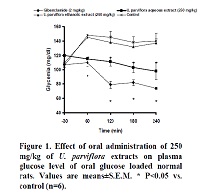Hypoglycemic activity of aqueous extract of Urtica parviflora roxb. in normoglycemic rats
Keywords:
Hypoglycemic activity, Urtica parviflora, Oral glucose tolerance testAbstract
In the present study aqueous and ethanolic extract of leaves of Urtica parviflora were evaluated for hypoglycemic effect in normal rats using both 18 hr fasted rat model and oral glucose tolerance test. The aqueous extract of leaves showed a good hypoglycemic response in both the models, while ethanolic extract exhibited very week but insignificant effect, only in 18 hr fasted rat model. The aqueous extract was further tested for effect on intestinal glucose absorption. The amount of glucose absorbed in a segment of jejunum in situ was 13±0.75 mg in presence of aqueous extract vs. vs. 9.05±0.68 mg in control rats during 2 h (P<0.05). Phytochemical screening of aqueous extract revealed the presence of alkaloids, reducing sugars, polysaccharides, tannins, saponins, glycosides and flavonoids. The results indicate that aqueous extract possess significant hypoglycemic activity which may be attributed to, in part by reduction of intestinal glucose absorption by the abovementioned chemical constituents.
References
Gurung G. The Medicinal Plants of Sikkim
Himalaya. Ist ed. Subhash Publication,
Sikkim; 1999.
Ramachandran K. Wealth of India (Raw
Materials). Publications and Information
Directorate, Council of Scientific and
Industrial Research, New Delhi; 1992.
Gulcin I, Kufrevioglu OI, Oktay M,
Buyukokuroglu ME. Antioxidant,
antimicrobial, antiulcer and analgesic
activities of nettle (Urtica dioica L.). J
Ethnopharmacol 2004; 90: 205-215.
Yongna Z, Wantana R, Pisit B, Zhongkun L,
Rongping Z. Analgesic and antipyretic
activities of the aqueous extract of Urtica
macrorrhiza in experimental animals.
Fitoterapia 2005; 76:91-95.
Kanter M, Coskun O, Budancamanak M.
Hepatoprotective effects of Nigella sativa L
and Urtica dioica L on lipid peroxidation,
antioxidant enzyme systems and liver
enzymes in carbon tetrachloride-treated rats.
World J Gastroenterol 2005; 11:6684-6688.
Obertreis B, Giller K, Teucher T, Behnke B,
Schmitz H. Anti-phlogistic effect of Urtica
dioica folium extract in comparison to
caffeoyl malic acid. Arzneimittel Forschung
; 46: 52-56.
Akbay P, Basaran AA, Undeger U, Basaran N.
In vitro immunomodulatory activity of
flavonoid glycosides from Urtica dioica L.
Phytother Res 2003; 17:34-37.
Legssyer A, Ziyyat A, Mekhfi H, Bnouham
M, Tahri A, Serhrouchni M, Hoerter J,
Fischmeister R. Cardiovascular effects of
Urtica dioica L. in isolated rat heart and aorta.
Phytother Res 2002; 16(6):503-507.
Prasana KK, Lilakanth N, Suvakanta D,
Sutharson L, Bhagabat N. Hepatoprotective
effect of the ethanolic extract of Urtica
parviflora Roxb. in CCl4 treated rats.
International Journal of Pharmacology 2007;
: 362-366.
Kavalali G, Tuncel H, Goksel S, Hatemi HH.
Hypoglycemic activity of Urtica pilulifera in
streptozotocin-diabetic rats. J
Ethnopharmacol 2003; 84:241-245.
Farzami B, Ahmadvand D, Vardasbi S, Majin
F.J, Khaghani S. Induction of insulin secretion
by a component of Urtica dioica leave extract
in perfused Islets of Langehans and its vivo
effects in normal and streptozotocin diabetic
rats. J Ethnopharmacol 2003;89: 47-53.
Bnouham M, Merhfour FZ, Ziyyat A, Mekhfi
H, Aziz M, Legssyer A. Antihyperglycemic
ctivity of the aqueous extract of Urtica dioica.
Fitoterapia 2003; 74:677-681.
Aslan M, Deliorman Orhan D, Orhan N, Sezik
E, Yesilada E. In vivo antidiabetic and
antioxidant potential of Helichrysum plicatum
ssp. Plicatum capitulums in streptozotocininduced diabetic rats. J Ethonopharmacol
; 109: 54-59.
Harbone JB. 1984. Phytochemical Methods. A
guide to Modern Techniques of Plant
Analysis, second ed. Chapman and Hall,
London, pp. 84-274.
Pan GY, Huang ZJ, Wang GJ, Fawcett JP, Liu
XD, Zhao XC, Sun JG, Xie YY. The
antihyperglycaemic activity of berberine
arises from a decrease of glucose absorption.
Planta Med. 2003; 69: 632–636.
Quanhong L, Caili F, Yukui R, Guanghui H,
Tongyi C. Effects of protein-bound
polysaccharide isolated from pumpkin on
insulin in diabetic rats. Plant Foods for Human
Nutrition 2005; 60:13-16.
Rao AV, Gurfinkel DM. The bioactivity of
saponins: triterpenoid and steroidal
glycosides. Drug Metabol. Drug Int. 2000; 17:
-235.
Mukherjee PK, Maiti K, Mukherjee K,
Houghton PJ. Leads from Indian medicinal
plants with hypoglycemic potentials. J
Ethnopharmacol 2006; 106:1-28.



